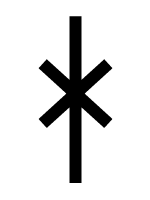Noleby Runestone on:
[Wikipedia]
[Google]
[Amazon]
 The Noleby Runestone, which is also known as the Fyrunga Runestone or Vg 63 for its Rundata catalog listing, is a
The Noleby Runestone, which is also known as the Fyrunga Runestone or Vg 63 for its Rundata catalog listing, is a
 for rather than for /a/ or /h/. The name Hakoþuz in the last line of the inscription is believed to mean "crooked one," although other interpretations have been suggested.
for rather than for /a/ or /h/. The name Hakoþuz in the last line of the inscription is believed to mean "crooked one," although other interpretations have been suggested.Twelve interpretations of the Noleby runestone text
The Noleby Runestone is now located in the
– Rundata.
Fyrungastenen
' in '' Nordisk familjebok'' (1908).
Photograph of Noleby Runestone
{{runestones Runestones in Västergötland
 The Noleby Runestone, which is also known as the Fyrunga Runestone or Vg 63 for its Rundata catalog listing, is a
The Noleby Runestone, which is also known as the Fyrunga Runestone or Vg 63 for its Rundata catalog listing, is a runestone
A runestone is typically a raised stone with a runic inscription, but the term can also be applied to inscriptions on boulders and on bedrock. The tradition began in the 4th century and lasted into the 12th century, but most of the runestones d ...
in Proto-Norse
Proto-Norse (also called Ancient Nordic, Ancient Scandinavian, Ancient Norse, Primitive Norse, Proto-Nordic, Proto-Scandinavian and Proto-North Germanic) was an Indo-European language spoken in Scandinavia that is thought to have evolved as a ...
which is engraved with the Elder Futhark. It was discovered in 1894 at the farm of Stora Noleby in Västergötland
Västergötland (), also known as West Gothland or the Latinized version Westrogothia in older literature, is one of the 25 traditional non-administrative provinces of Sweden (''landskap'' in Swedish), situated in the southwest of Sweden.
Väs ...
, Sweden.
Description
The Noleby Runestone was dated bySophus Bugge
Elseus Sophus Bugge (5 January 1833 – 8 July 1907) was a Norwegian philologist and linguist. His scholarly work was directed to the study of runic inscriptions and Norse philology. Bugge is best known for his theories and his work on the runic ...
to about 600 AD, and cannot be dated any younger than about 450 AD due to its language and rune forms. It is notable because of its inscription ''runo ..raginakundo'' which means "runes of divine origin" and which also appears in the later Sparlösa Runestone
The Sparlösa Runestone, listed as Vg 119 in the Rundata catalog, is located in Västergötland and is the second most famous Swedish runestone after the Rök runestone.
Description
The Sparlösa Runestone was discovered in 1669 in the southe ...
and the eddic poem ''Hávamál
''Hávamál'' ( ; Old Norse: ,Unnormalised spelling in the :Title: Final stanza: ../ref> classical pron. , Modern Icelandic pron. , ‘Words of he High One��) is presented as a single poem in the Icelandic , a collection of Old Norse poems fr ...
''. This is of importance for the study of Norse mythology since it indicates that the expressions and the contents of the ''Poetic Edda
The ''Poetic Edda'' is the modern name for an untitled collection of Old Norse anonymous narrative poems, which is distinct from the ''Prose Edda'' written by Snorri Sturluson. Several versions exist, all primarily of text from the Icelandic med ...
'' are indeed of pre-historic Scandinavian origin.
The runic inscription consists of three lines of text between bands, with the second line considered untranslatable and often listed as being a "meaningless formula." The Noleby is the only runestone in Scandinavia
Scandinavia; Sámi languages: /. ( ) is a subregion in Northern Europe, with strong historical, cultural, and linguistic ties between its constituent peoples. In English usage, ''Scandinavia'' most commonly refers to Denmark, Norway, and Swe ...
that uses the star rune form  for rather than for /a/ or /h/. The name Hakoþuz in the last line of the inscription is believed to mean "crooked one," although other interpretations have been suggested.
for rather than for /a/ or /h/. The name Hakoþuz in the last line of the inscription is believed to mean "crooked one," although other interpretations have been suggested.The Noleby Runestone is now located in the
Swedish Museum of National Antiquities
The Swedish History Museum ( sv, Historiska museet or Statens historiska museum) is a museum located in Stockholm, Sweden, that covers Swedish archaeology and cultural history from the Mesolithic period to present day. Founded in 1866, it operates ...
in Stockholm.
Inscription
Below follows a presentation of the runestones based on the Rundata project. The transcriptions into Old Norse are in the Swedish and Danish dialect to facilitate comparison with the inscriptions, while the English translation provided by Rundata gives the names in the de facto standard dialect (the Icelandic and Norwegian dialect):Transcription of the runes into Latin letters
: runo fahi raginakudo toj-a ¶ unaþou ÷ suhurah : susi(h)—tin ¶ hakuþoProject Samnordisk Runtextdatabas Svensk– Rundata.
Transliteration into Proto Norse
: ''Runo fahi raginakundo toj 'k. ... Hakoþuz.''Translation into English
: "I prepare the suitable divine rune ... for Hakoþuz."See also
*Jēran
Jera (also Jeran, Jeraz) is the conventional name of the ''j''-rune of the Elder Futhark, from a reconstructed Common Germanic stem 'C.f. Page (2005:15). The word may have been either neuter or masculine in Common Germanic. meaning "harvest, (g ...
References
Other sources
* The articleFyrungastenen
' in '' Nordisk familjebok'' (1908).
External links
Photograph of Noleby Runestone
{{runestones Runestones in Västergötland